New Book Releases / Autumn 2023
If you would like to alert us to a recent or forthcoming film publication for the next round-up in winter, please contact us here. For notes on more books, see David Hudson’s monthly round-up at Criterion’s The Daily.

Let’s start with three new books, all published by Leuven University Press, which Sabzian collaborators were involved with in different ways. The first publications are dedicated to the writing of the Belgian critic Dirk Lauwaert (1944-2013). His film criticism is not, as yet, internationally recognized. To provide a corrective to this, Sabzian has published many new English translations of Lauwaert’s writings on film over the past years and will continue to do so up until November. Edited by Herman Asselberghs, Robbrecht Desmet, Bart Meuleman and Peter Jan Perquy, Dirk Lauwaert: Selected Writings, 1983-2008 will be the first introduction of this key Belgian writer and critic to an English-speaking audience. This anthology presents the depth and scope of Lauwaert’s immense output through fifteen key texts in which the Belgian author unfolds his central ideas and motifs. The texts span twenty-five years – from 1983 to 2008 – and were originally published in various contexts over the course of three decades. A second publication, Zelfportret [Self-Portrait], will be in Dutch and offer a collection of Lauwaert’s autobiographical texts, compiled by his close friend and collaborator Bart Meuleman. Both publications will be presented on November 9 at the Passa Porta Bookshop in Brussels.
The filmmaker and artistic director of Sabzian, Gerard-Jan Claes, and the philosopher Stéphane Symons edited Francis Alÿs: The Nature of the Game, which also includes an interview they’ve conducted with the Belgian artist and one of his collaborators, Rafael Ortega. The book focuses on Children’s Games, their extensive collection of videos of children at play, shot around the world for over almost twenty-five years and now numbering around thirty-five works. This volume includes a series of essays by scholars and art critics, curatorial statements and a logbook related to the presentation of Children’s Games at the Venice Biennale of 2022. This open-access publication is free to download as an ebook (pdf). The paperback will be published at the beginning of next month.
Whereas Francis Alÿs’s videos are proof of the seriousness of play, the following book also gathers the writings and thinking of someone who tirelessly explored the capability of the camera as a means of documenting children’s activities. The French pedagogue Fernand Deligny worked and lived with autistic children and captured images to trace their movements, wanderings and gestures as part of his experimental “attempts” – or “tentatives”, as he referred to them in French. Although we missed the publication of Camering: Fernand Deligny on Cinema and the Image more than a year ago, the appearance of this English translation was celebrated with a symposium at the beginning of this year. In addition to the 2013 translations by the University of Minnesota Press and L’Arachnéen, this volume is an important new step to make Deligny’s texts available outside French-speaking communities. Last year, Sabzian published five texts by Deligny, introduced by Mattijs Driesen and translated for the first time into Dutch by Veva Leye and Sis Matthé, with the support of LUCA School of Arts. You can find the table of contents of this new volume and read the introduction on the website of the publisher, Leiden University Press.
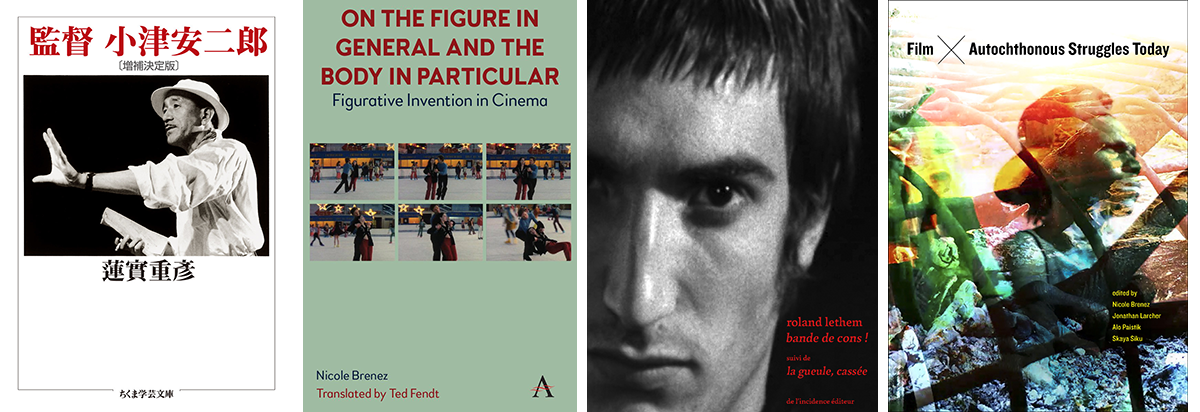
Two other major new English translations can be announced. First, Shigehiko Hasumi’s book on Yasujirô Ozu is being fully translated into English by Aaron Gerow and Ryan Cook for the University of California Press! In his essay “Ozu to Asia via Hasumi”, Gerox called it “arguably the most influential book on Ozu in Japan”. Kantoku Ozu Yasujiro [Director Ozu Yasujiro] was originally published in 1983 and enlarged in a definitive edition in 2003. A French translation of the book was published by Cahiers du cinéma in 1998. In “Three Hours with Professor Hasumi on a Train, in Japan”, the filmmaker Pedro Costa specified what sets this “very special writer” apart from the rest:
“Hasumi doesn’t write from a critic’s point of view; he writes from a filmmaker’s point of view. In every text, about whichever film, we really feel that he is speaking from ‘inside’ the film, not from a distance or from the outside. Every time I read something by Hasumi, he never ceases to hold tight to this secret gift. […] I remembered that his book on Ozu was divided into chapters or sections entitled ‘to eat’, ‘to change clothes’, ‘to see’, ‘to live’, ‘to stop’ ... I wondered what Roberto Rossellini would have thought of this. The author of India: Matri Bhumi (1959) used to say that, to make a film, all you had to do was to draw a diagram on a blackboard and write down ‘food’, ‘clothing’, ‘domestic habits’, ‘weather’, every detail you could gather from a serious observation of a determined community or country. This would be your screenplay, all abstraction and unnecessary poetry removed, and the film would be ready to shoot.”
The publication date is still unknown, but Aaron Gerow was trying to finish up the translation check last May. Here’s a collection by Emerson Goo of links to pieces by Hasumi online, in English or translated into English.
The critic Jonathan Rosenbaum who “went to the trouble of even using a dictionary to read it”, noted that “the incredible thing about Hasumi’s book on Ozu is it takes the reverse position of everything that’s said in the west about Ozu.” Rosenbaum also called the second, major translation we’ve mentioned, “the most valuable volume by a French cinephile in English to have appeared since the translations of André Bazin and Serge Daney – a book that I believe filmgoers will still be learning from half a century from now.” He’s talking about the translation of Nicole Brenez’s On The Figure In General And The Body In Particular: Figurative Invention In Cinema by the filmmaker, critic and projectionist Ted Fendt (Outside Noise). In this collection of wide-ranging essays written throughout the 1990s, Brenez proposes an original method of cinematic analysis and interpretation foregrounding film’s formal and plastic qualities in all their multifaceted materiality and aesthetics. She reconsiders what a body on film can be and what constitutes a figure in cinema. While glimpses of these concepts have appeared in scattered translations over the years, this collection represents the first comprehensive and expansive selection of her writings on cinema in English. This translation of “one of the true classics of 1990s film theory and analysis”, dixit Adrian Martin, was published last July from Anthem Press.
Not only are there translations of Nicole Brenez's work, but new publications are also forthcoming. Brenez coordinated a collection on the Belgian experimental filmmaker and writer Roland Lethem, Bande de cons ! , suivi de La Gueule, cassée. Appearing next month from De l’Incidence éditeur, this volume reproduces the text of Lethem’s film Bande de cons ! (1970) and a short story written by him in 1974, La Gueule, cassée, which Lethem self-published a small number of to raise funds for a film. The two texts are supplemented by an unpublished introduction by Roland Lethem and by texts by the film and art historians Isabelle Marinone and Xavier García Bardón, the latter of who describes the text of Bande de cons ! as “the ultimate pamphlet against the Spectacle”.
Meanwhile, Nicole Brenez is also editing a new English-language collection together with Jonathan Larcher, Alo Paistik and Skaya Siku. Forthcoming next spring from Sternberg Press, Film X Autochthonous Struggles Today will bring together for the first time filmmakers, activists, film curators and scholars who share a common interest in filmmaking practices that emerge from and participate in the various situations of struggle that the Autochthonous/Indigenous/Native/Aboriginal/First Nations peoples and communities are involved in worldwide.
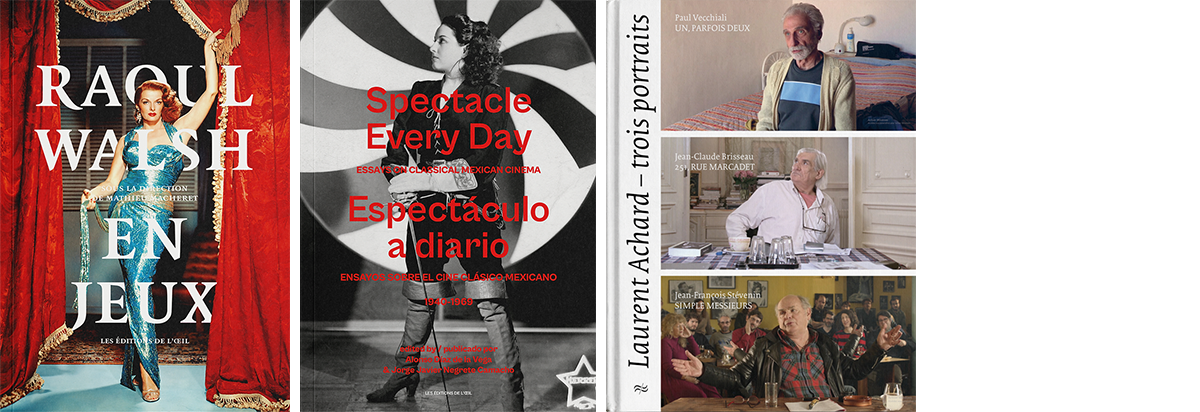
Next up are three new books from the French publisher Les éditions de l’oeil. First, Raoul Walsh – En jeux looks at the work of this American filmmaker through the long partnerships he nurtured with some of Hollywood’s most essential actors, each playing a specific role in his cinema (James Cagney, Ida Lupino, Errol Flynn, Clark Gable, etc.). Published last month, this collection was coordinated by Mathieu Macheret, the film critic for Le Monde, and contains contributions by Olivia Cooper-Hadjian, Pierre Eugène, Murielle Joudet, Gaël Lépingle, Jean-Marie Samocki and Marcos Uzal, among others.
Also released last month from the same publisher, Spectacle Every Day: Essays on Classical Mexican Cinema (1940-1969) is a bilingual (EN/ES) collection of ten texts that delve into the classical period of one of the richest yet least researched film cultures in the world. The book is published on the occasion of the much applauded retrospective of the same name, curated by Olaf Möller in collaboration with Roberto Turigliatto, at last month’s Locarno Film Festival. More than two years in the making, this unprecedented overview was one of the largest international retrospectives of Mexican popular cinema in decades, encompassing thirty-six titles of varying genres, including many never-before-seen works.
The DVD-book Laurent Achard: Trois portraits collects the three portraits filmed by Laurent Achard of the French filmmakers Paul Vecchiali, Jean-Claude Brisseau and Jean-François Stévenin, each part of the series Cinéastes, de notre temps. Published this summer, the accompanying sixty-four-page booklet includes three texts by Vecchiali, the Libération film critic Olivier Séguret and the writer Laurent Mauvignier.
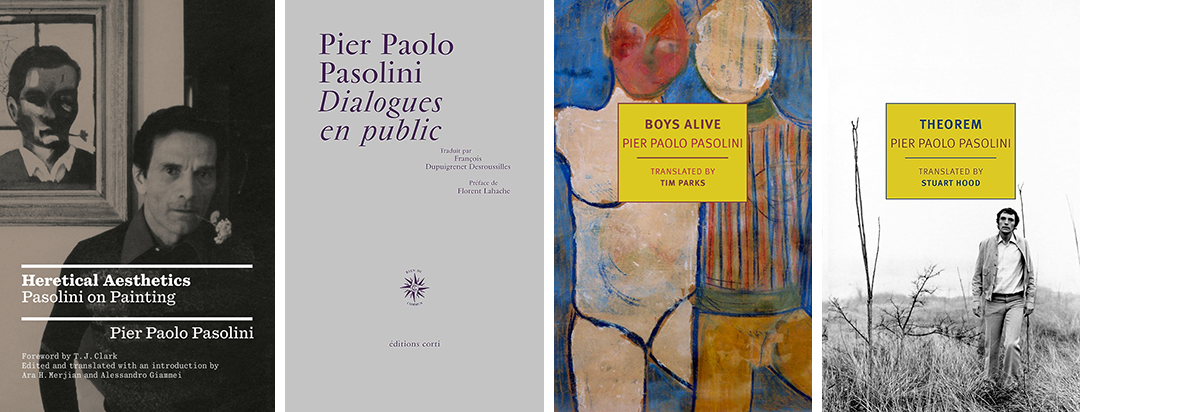
The following cluster of books consists of new publications of the writings of Pier Paolo Pasolini. Published by Verso Books last month, Heretical Aesthetics: Pasolini on Painting proves that Pasolini, who studied under the distinguished art historian Roberto Longhi, was also a keen critic of painting. This collection offers numerous texts previously available only in Italian, each accompanied by an editorial note elucidating its place in the context of post-war Italian culture. You can read Pasolini on Caravaggio, Warhol and Picasso, among others. Prefaced by the renowned art historian T. J. Clark, a historical essay on Pasolini’s radical aesthetics anchors this anthology which “fills a huge lacuna in Pasolini studies”, according to Angela Dalle Vacche, the expert in the field of cinema and painting.
Published last spring by Editions Corti, Dialogues en public gathers the many letters that Pier Paolo Pasolini received from mechanics, high-school students, workers, mothers, librarians, young communists, Catholics etc. from all over the country with remarks, requests and questions. Pasolini responded assiduously and often at length, every week, in the pages of the communist magazine Vie Nuove, where, between 1960 and 1965, he had his own section titled “Dialoghi con Pasolini”. This anthology takes up the most significant exchanges, which allow us to grasp the singularity of this epistolary experiment and its literary and political resonances. A first version of these dialogues was published in 1980 by Les éditions du Sorbier but was never reissued since then. You can find the table of contents and read the introduction on the publisher’s website.
Next November, NYRB Classics will release new translations of Pier Paolo Pasolini’s first and third novel, Boys Alive [Ragazzi di vita] (1955) and Theorem [Teorema] (1968). The former will be newly translated and introduced by Tim Parks. It has appeared in English before with three different titles: The Hustlers, The Ragazzi (trans. Emile Capouya, Grove Press, 1968) and The Street Kids (trans. Ann Goldstein, Europa Editions, 2006). Making its US debut, Theorem is a reissue of the 1992 translation from Quartet Books by the late Scottish writer Stuart Hood.
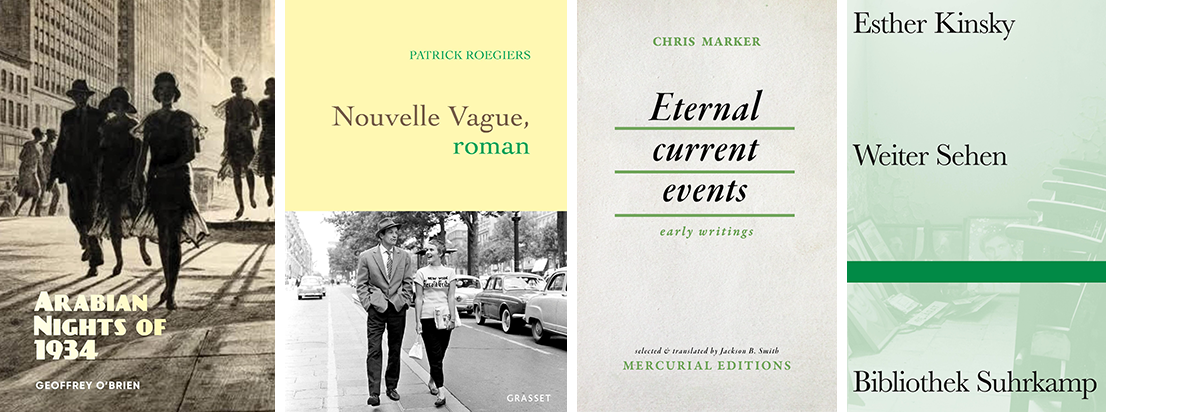
Nothing to do with Pier Paolo Pasolini’s Arabian Nights, the next novel is a journey through the fevered dreamworld embodied in Pre-Code Hollywood movies of the early 1930s. Two of the moviegoing characters in Arabian Nights of 1934 are the author Geoffrey O’Brien’s own parents in their restless youth. O’Brien is a poet, cultural historian and contributor to The New York Review of Books, Bookforum, Artforum, Film Comment and other periodicals. Last month, Film International ran an interview with him about this book that appeared in May from Terra Nova Press.
In her equally genre-bending, new novel, the distinguished German writer Esther Kinsky also turns to the cinema to explore the movie theatre as a refuge for everyone, a place that offered shelter for countless solitudes, hopes and dreams. In Weiter Sehen: Von der unwiderstehlichen Magie des Kinos, a woman who’s passing through tries to revive a dilapidated village cinema called the Mozi and the social life around it. Sometimes compared to her compatriot W. G. Sebald, Kinsky included forty photographs in the novel. Originally released by Suhrkamp Verlag in April, the Dutch translation, Verder Kijken, appeared from the publishing house Pluim last month. Other translations will appear from NYRB (US/Canada), Fitzcarraldo (UK) and Christian Bourgois éditeur (FR).
Whereas Geoffrey O’Brien evoked the atmosphere of Pre-Code Hollywood, the following novel does so for the period of the Nouvelle Vague. In his well-documented ciné-roman, Nouvelle Vague, the French-Belgian writer Patrick Roegiers (1947, Brussels) takes the reader behind the scenes of about fifteen films where filmmakers-cum-characters such as Jean-Luc Godard, François Truffaut, Claude Chabrol and Eric Rohmer defend their conceptions of cinema and aesthetic choices. The novel was published last April by Grasset.
One can sometimes forget that Chris Marker – conspicuously absent in Patrick Roegiers’s abovementioned chronicle of the 1950s Paris film scene – was also a writer of short stories, essays, poems and fabricated reportage before making his first films. Often blurring reality and imagination in his pieces, Marker was a regular contributor to the magazine Esprit from 1946 to 1952. Forthcoming next month from Impatient Press, Eternal Current Events: Early Writings marks the first time these texts will be available in English, published in an adapted facsimile of the original periodical.
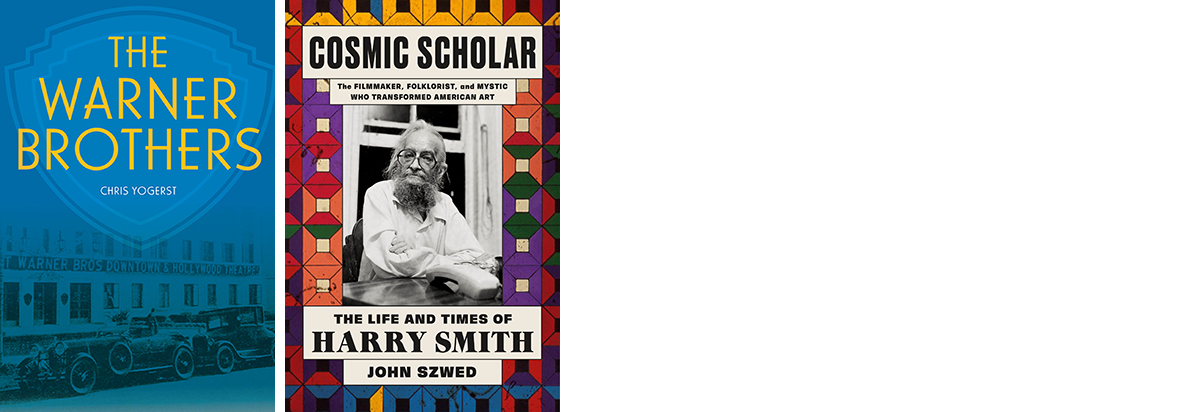
We’ve selected two new, centenary biographies of pioneering figures, including two Harry’s, one from the heart of the Hollywood studio system, the other from the underground. Out from the University Press of Kentucky this month, The Warner Brothers tells the story of the Bros. Jack, Harry, Samuel and Albert Warner, starting from their Jewish family’s humble origins in Poland. The film historian Kevin Brownlow and the renowned biographer Scott Eyman have praised Chris Yogerst’s well-researched account as “epic” and “marvelous”.
Chris Yogerst pays close attention to the Warner brothers’ identities as cultural and economic outsiders, but that’s nothing compared to the life and work of the ultimate bohemian and true eccentric, Harry Smith (1923-1991). Cosmic Scholar: The Life and Times of Harry Smith is the first comprehensive biography of this enigmatic experimental filmmaker, polymath, painter, anthropologist, archivist, mystic and father of the Anthology Of American Folk Music. Thoroughly researched by John Szwed, the veteran biographer of Alan Lomax, Miles Davis and Sun Ra, the book was published last month by Farrar, Straus and Giroux.
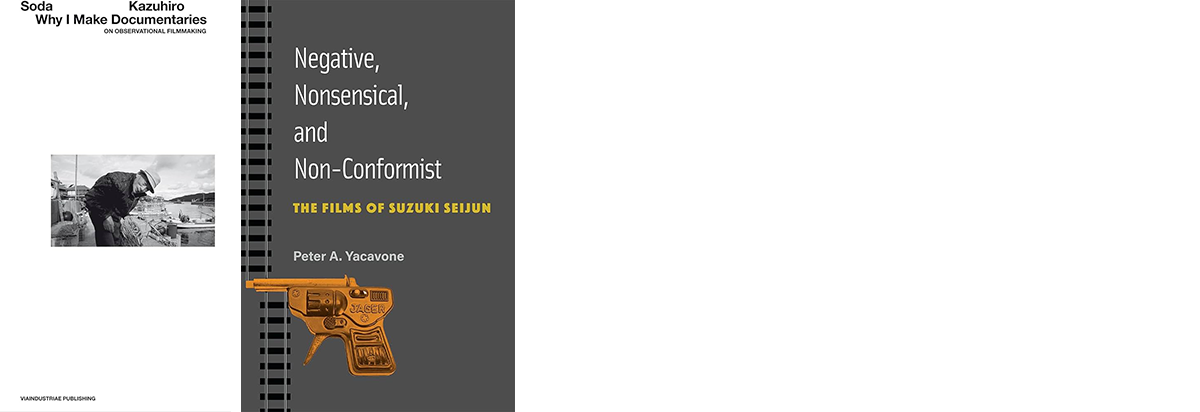
Two Japanese directors who both rejected all restrictive filmmaking norms are the focus of new publications that appeared last spring. Out from the University of Michigan Press, Negative, Nonsensical, and Non-Conformist: The Films of Suzuki Seijun provides an analysis of Suzuki’s forty-nine feature films. Being fired by Nikkatsu Studios after Branded To Kill (1967) for making “films that make no sense and make no money”, Suzuki reinvented himself as an independent filmmaker. Peter A. Yacavone’s book is available as a paperback and hardcover but also as a free, open-access publication.
The Japanese independent documentary filmmaker Kazuhiro Soda wrote a reflexive diary on his own work, Why I Make Documentaries: On Observational Filmmaking. Soda practices a method based on his own “Ten Commandments” which prohibits him from doing pre-shoot research or writing a synopsis before filming. Published by Viaindustriae publishing, this first curated English version of his most enlightening and complete text has been enriched with a brand-new iconographic apparatus from Soda’s films and a new updated introduction by the author himself.
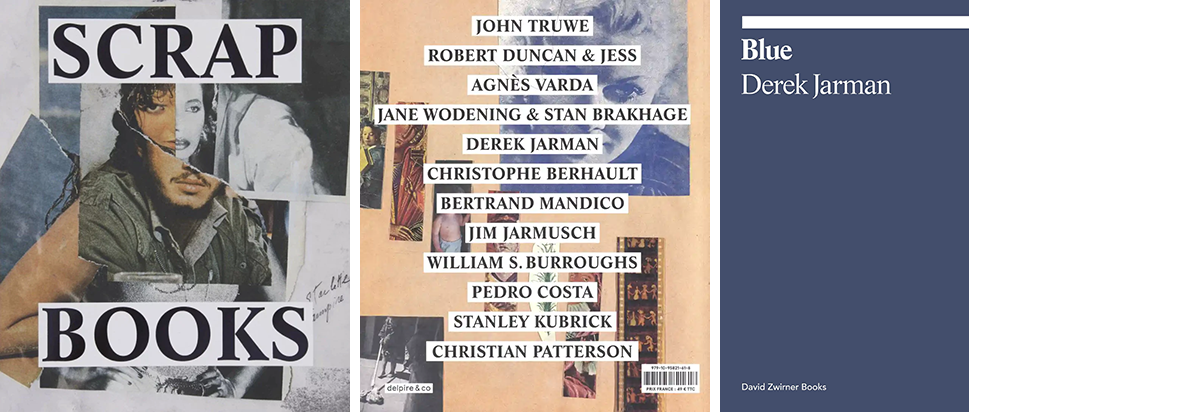
More visual diaries can be found in Scrapbooks, published last June on the occasion of the eponymous exhibition that ran at the Espace Van Gogh until this week and was initially set up in the framework of the Rencontres d’Arles. This book presents some of the most beautiful scrapbooks of filmmakers, photographers, poets and artists, such as Pedro Costa, Stanley Kubrick and Stan Brakhage. It offers a journey to the origin of the creation of their films, giving access to private documents. Published by Delpire & co, the book was edited by Matthieu Orléan who also curated the exhibition.
As a brief aside, note that Agnès Varda is included in the latter publication with her scrapbooks, but the same publishing house also issued two other publications on Varda in their collection of Carnets. These bilingual (FR/EN) Carnets are dedicated to Varda’s first solo exhibition, Expo54, and her first film, La pointe courte, both made in 1954. The latter booklet is made up of the photographs she took in Sète between 1952 and 1954 that would later serve to prepare La pointe courte but pre-existed the idea for the film.
The Varda bibliography is ever expanding... This week, Gallimard will publish Agnès Varda, a biographical essay by the filmmaker’s longtime friend, Laure Adler. Next month, Editions de la Martinière will also publish the catalogue of the Viva Varda ! exhibition at the Cinémathèque française and the autobiographical Varda par Agnès: L’intégrale consisting of two volumes: a reissue of the first 1994 out-of-print Cahiers du cinéma edition (1954-1994) and a new, second volume (spanning 1994-2019). In November, Delmonico Books will come with the English-language tribute publication and visual showcase Agnès Varda: Director’s Inspiration.
Also part of the Scrapbooks above, Derek Jarman completed his last feature, Blue (1993), only a few months before his AIDS-related death when he had already become partially blind. Blue consists of a blue screen with a voiceover and soundtrack. A new booklet, Blue, reproduces the film and its script. An introduction by the art historian Michael Charlesworth brings Blue into conversation with Jarman’s paintings. Published last March, this release is part of David Zwirner Books’s ekphrasis series dedicated to publishing rare, out-of-print and newly commissioned texts as accessible paperback volumes. Blue: Text of a Film, the 1993 edition issued by Channel 4 Television, dated back to the year of film’s release.
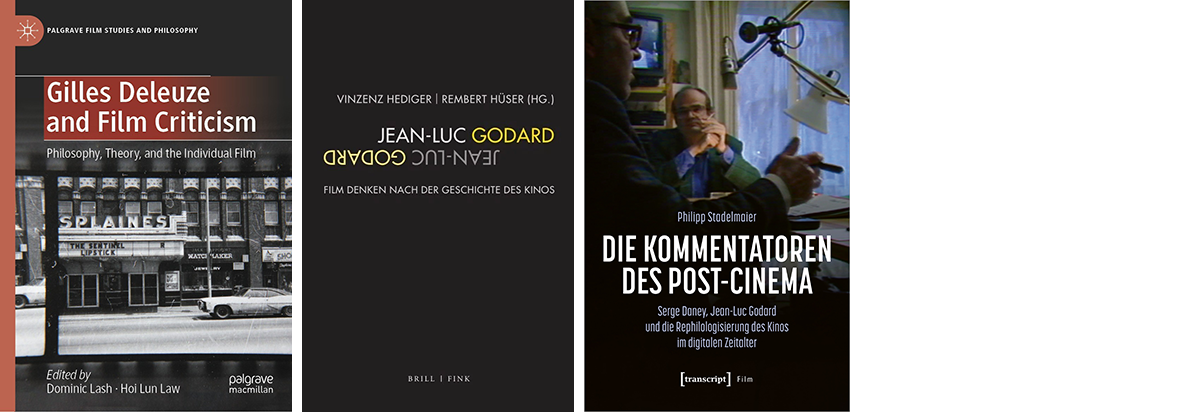
Published last month by Palgrave Macmillan, Gilles Deleuze and Film Criticism: Philosophy, Theory and the Individual Film is a collection of essays examining the role that close attention to individual films plays in the philosopher Gilles Deleuze’s work on cinema. Edited by Dominic Lash and Hoi Lun Law, the book includes contributions by Andrew Klevan, Daniel Morgan and Joe McElhaney (on Stanley Donen and Vincente Minnelli), among others.
Another volume takes Jean-Luc Godard’s work and thinking as the starting point for a reflection on the histories and futures of cinema. Edited by Vinzenz Hediger and Rembert Hüser, Jean-Luc Godard: Film denken nach der Geschichte des Kinos includes a stellar line-up of contributors, such as Jacques Aumont, Raymond Bellour, Nicole Brenez, Georges Didi-Huberman, Daniel Fairfax, Adrian Martin, Volker Pantenburg and Michael Witt. A German-language e-book and paperback were published by Brink in May and July, respectively.
Early on, Jean-Luc Godard asked himself the question of what comes after the cinema, this “invention without a future”, as Louis Lumière once called his own creation. Another German-language publication brings Godard together with the French film critic Serge Daney as commentators on cinema and its history in a post-cinema age. The German film critic Philipp Stadelmaier aims to steer the post-cinema debates away from a focus on the dispositif and provide it with a cine-philological impulse through Godard’s and Daney’s cinephilia and love of writing. Die Kommentatoren des Post-Cinema: Serge Daney, Jean-Luc Godard und die Rephilologisierung des Kinos im digitalen Zeitalter was released this month from Transcript Verlag as a hardcopy but also as an open-access publication.
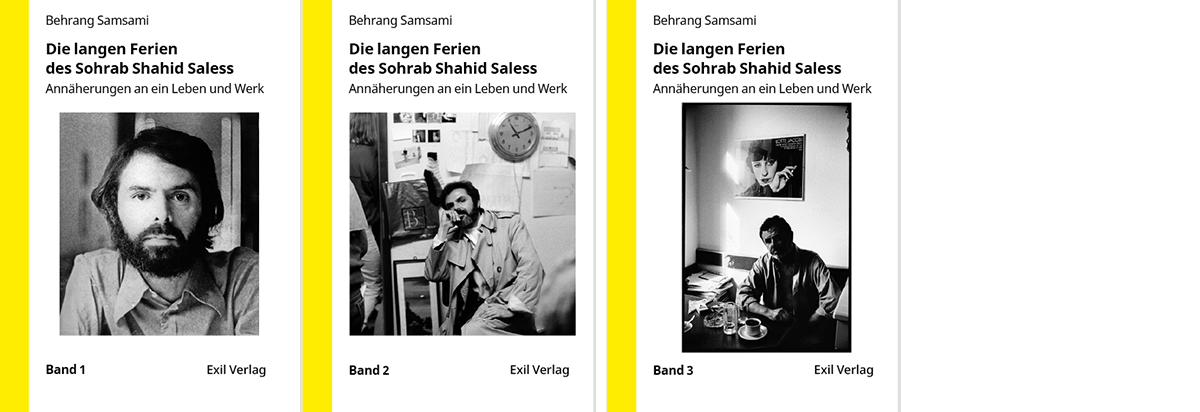
Fifteen hundred more pages of German-language publications! Coming in three volumes, Die langen Ferien des Sohrab Shahid Saless is the first comprehensive, German-language account of the life and work of the Iranian screenwriter and filmmaker of A Simple Event (1974) and Still Life (1974). The great unknown of the New German Film, Sohrab Shahid Saless (1944-1998) is hardly recognized in his German homeland of exile, where he lived intermittently between 1974 and 1995. Volume 1 presents a comprehensive biography. The second tome offers analyses of the feature films and documentaries that Saless has made since 1973. The last volume contains interviews with companions about Saless and selected personal testimonies, such as letters and film drafts. This collection will be published at the end of this month by Exile Verlag.
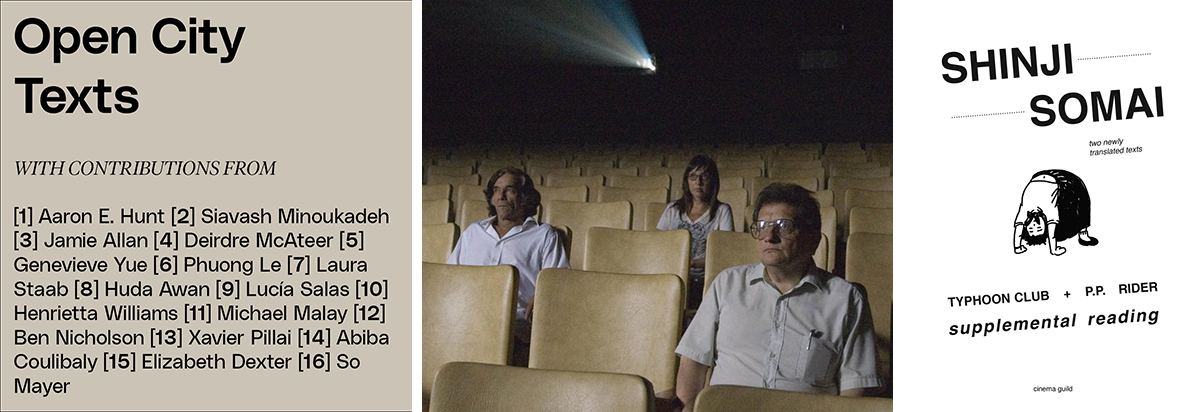
Meanwhile, the film magazine Little White Lies, founded eighteen years ago, has launched its hundreth issue this month – “a difficult number to reach in the ultra-precarious world of independent publishing”, the editor David Jenkins writes. They “have to expend more and more energy on developing sustainable funding routes” and ask you to consider joining Club LWLies.
“We had hoped that we would reach the age of 100, but 93 is pretty damned old. We still might get there,” the editor-publisher Mark Peranson wrote in his Cinema Scope editorial in issue #93 (winter 2023). In the latest issue #96, he sounds less sure: “I have reached the conclusion that I am 99 percent sure that this will be the penultimate issue of this magazine with the current publishing schedule of four issues per year. […] I’m withholding any final reflections until we make it to the winter, at which point I will try my best to provide more news.” As the contributor Adam Nayman wrote: “Hopefully people will read this, notice, and respond, not least of all by letting him [Mark Peranson] know that whatever happens, the magazine matters to our community.”
The Open City Documentary Festival, which just had its thirteenth edition this month, launched Open City Texts, with the hope of providing a space for new writing on non-fiction film. This series of texts has been commissioned to accompany the screenings of new films in their program. Among the contributors, you can find Genevieve Yue, Laura Staab, Lucía Salas, So Mayer and many more.
Taking off next month, the Viennale film festival will dedicate the sixth volume in their TEXTUR series to the Argentinian filmmaker Lisandro Alonso (Eureka). Each publication in this series focuses on one contemporary filmmaker and aims to portray his or her working methods as a diverse texture, compiling a range of influences and collaborations. TEXTUR #6 will feature contributions from the curators Olivier Père and Cecilia Barrionuevo, the film critics Lucía Salas and Quintín and the film professionals Miguel Gomes and Viggo Mortensen, among others.
This month, New York’s IFC Center organized four screenings of P. P. Rider (1983) and released the new 4K restoration of Typhoon Club (1985) which is still on the program. On the occasion of the revival of these two films by Shinji Somai, a pivotal figure of Japanese cinema in the 1980s, the distributor Cinema Guild issued a twenty-four-page zine featuring two newly translated texts: a 2011 essay by Ryusuke Hamaguchi and the transcript of a 1990 lecture by Shinji Somai. The limited run zine is distributed free of charge in the cinema. You’ll be lucky to find one of the very last copies. As the critic Shigehiko Hasumi – with whom we started this book wrap – put it: “While never having the fluid movement of Mizoguchi or Ophuls, Shinji Somai’s camera perseveres, risking the appearance of clumsiness, nestling against his characters’ unpredictable behavior, now hesitant, now abruptly decisive.”

